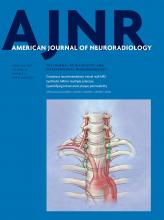Index by author
Kallmes, D.F.
- NeurointerventionYou have accessDiffusion-Weighted Imaging–Detected Ischemic Lesions following Endovascular Treatment of Cerebral Aneurysms: A Systematic Review and Meta-AnalysisK.M. Bond, W. Brinjikji, M.H. Murad, D.F. Kallmes, H.J. Cloft and G. LanzinoAmerican Journal of Neuroradiology February 2017, 38 (2) 304-309; DOI: https://doi.org/10.3174/ajnr.A4989
Kamagata, K.
- FELLOWS' JOURNAL CLUBADULT BRAINOpen AccessSynthetic MRI in the Detection of Multiple Sclerosis PlaquesA. Hagiwara, M. Hori, K. Yokoyama, M.Y. Takemura, C. Andica, T. Tabata, K. Kamagata, M. Suzuki, K.K. Kumamaru, M. Nakazawa, N. Takano, H. Kawasaki, N. Hamasaki, A. Kunimatsu and S. AokiAmerican Journal of Neuroradiology February 2017, 38 (2) 257-263; DOI: https://doi.org/10.3174/ajnr.A5012
In this retrospective study, synthetic T2-weighted, FLAIR, double inversion recovery, and phase-sensitive inversion recovery images were produced in 12 patients with MS after quantification of T1 and T2 values and proton density. Double inversion recovery images were optimized for each patient by adjusting the TI. The number of visible plaques was determined by a radiologist for a set of these 4 types of synthetic MR images and a set of conventional T1-weighted inversion recovery, T2-weighted, and FLAIR images. Conventional 3D double inversion recovery and other available images were used as the criterion standard. Synthetic MR imaging enabled detection of more MS plaques than conventional MR imaging in a comparable acquisition time (approximately 7 minutes). The contrast for MS plaques on synthetic double inversion recovery images was better than on conventional double inversion recovery images.
Kaneko, O.F.
- ADULT BRAINYou have accessThe “White Gray Sign” Identifies the Central Sulcus on 3T High-Resolution T1-Weighted ImagesO.F. Kaneko, N.J. Fischbein, J. Rosenberg, M. Wintermark and M.M. ZeinehAmerican Journal of Neuroradiology February 2017, 38 (2) 276-280; DOI: https://doi.org/10.3174/ajnr.A5014
Katorza, E.
- Pediatric NeuroimagingYou have accessFetal Brain Anomalies Associated with Ventriculomegaly or Asymmetry: An MRI-Based StudyE. Barzilay, O. Bar-Yosef, S. Dorembus, R. Achiron and E. KatorzaAmerican Journal of Neuroradiology February 2017, 38 (2) 371-375; DOI: https://doi.org/10.3174/ajnr.A5009
Kawasaki, H.
- FELLOWS' JOURNAL CLUBADULT BRAINOpen AccessSynthetic MRI in the Detection of Multiple Sclerosis PlaquesA. Hagiwara, M. Hori, K. Yokoyama, M.Y. Takemura, C. Andica, T. Tabata, K. Kamagata, M. Suzuki, K.K. Kumamaru, M. Nakazawa, N. Takano, H. Kawasaki, N. Hamasaki, A. Kunimatsu and S. AokiAmerican Journal of Neuroradiology February 2017, 38 (2) 257-263; DOI: https://doi.org/10.3174/ajnr.A5012
In this retrospective study, synthetic T2-weighted, FLAIR, double inversion recovery, and phase-sensitive inversion recovery images were produced in 12 patients with MS after quantification of T1 and T2 values and proton density. Double inversion recovery images were optimized for each patient by adjusting the TI. The number of visible plaques was determined by a radiologist for a set of these 4 types of synthetic MR images and a set of conventional T1-weighted inversion recovery, T2-weighted, and FLAIR images. Conventional 3D double inversion recovery and other available images were used as the criterion standard. Synthetic MR imaging enabled detection of more MS plaques than conventional MR imaging in a comparable acquisition time (approximately 7 minutes). The contrast for MS plaques on synthetic double inversion recovery images was better than on conventional double inversion recovery images.
- ADULT BRAINOpen AccessUtility of a Multiparametric Quantitative MRI Model That Assesses Myelin and Edema for Evaluating Plaques, Periplaque White Matter, and Normal-Appearing White Matter in Patients with Multiple Sclerosis: A Feasibility StudyA. Hagiwara, M. Hori, K. Yokoyama, M.Y. Takemura, C. Andica, K.K. Kumamaru, M. Nakazawa, N. Takano, H. Kawasaki, S. Sato, N. Hamasaki, A. Kunimatsu and S. AokiAmerican Journal of Neuroradiology February 2017, 38 (2) 237-242; DOI: https://doi.org/10.3174/ajnr.A4977
Kim, H.
- EDITOR'S CHOICEFUNCTIONALOpen AccessMicrostructure of the Default Mode Network in Preterm InfantsJ. Cui, O. Tymofiyeva, R. Desikan, T. Flynn, H. Kim, D. Gano, C.P. Hess, D.M. Ferriero, A.J. Barkovich and D. XuAmerican Journal of Neuroradiology February 2017, 38 (2) 343-348; DOI: https://doi.org/10.3174/ajnr.A4997
A cohort of 44 preterm infants underwent T1WI, resting-state fMRI, and DTI at 3T, including 21 infants with brain injuries and 23 infants with normal-appearing structural imaging as controls. Neurodevelopment was evaluated with the Bayley Scales of Infant Development at 12 months' adjusted age. Results showed decreased fractional anisotropy and elevated radial diffusivity values of the cingula in the preterm infants with brain injuries compared with controls. The Bayley Scales of Infant Development cognitive scores were significantly associated with cingulate fractional anisotropy. The authors suggest that the microstructural properties of interconnecting axonal pathways within the default mode network are of critical importance in the early neurocognitive development of infants.
Kim, H.C.
- Head and Neck ImagingYou have accessFirst-Line Use of Core Needle Biopsy for High-Yield Preliminary Diagnosis of Thyroid NodulesH.C. Kim, Y.J. Kim, H.Y. Han, J.M. Yi, J.H. Baek, S.Y. Park, J.Y. Seo and K.W. KimAmerican Journal of Neuroradiology February 2017, 38 (2) 357-363; DOI: https://doi.org/10.3174/ajnr.A5007
Kim, K.W.
- Head and Neck ImagingYou have accessFirst-Line Use of Core Needle Biopsy for High-Yield Preliminary Diagnosis of Thyroid NodulesH.C. Kim, Y.J. Kim, H.Y. Han, J.M. Yi, J.H. Baek, S.Y. Park, J.Y. Seo and K.W. KimAmerican Journal of Neuroradiology February 2017, 38 (2) 357-363; DOI: https://doi.org/10.3174/ajnr.A5007
Kim, Y.J.
- Head and Neck ImagingYou have accessFirst-Line Use of Core Needle Biopsy for High-Yield Preliminary Diagnosis of Thyroid NodulesH.C. Kim, Y.J. Kim, H.Y. Han, J.M. Yi, J.H. Baek, S.Y. Park, J.Y. Seo and K.W. KimAmerican Journal of Neuroradiology February 2017, 38 (2) 357-363; DOI: https://doi.org/10.3174/ajnr.A5007
Kranz, P.G.
- Spine Imaging and Spine Image-Guided InterventionsYou have accessInadvertent Intrafacet Injection during Lumbar Interlaminar Epidural Steroid Injection: A Comparison of CT Fluoroscopic and Conventional Fluoroscopic GuidanceP.G. Kranz, A.B. Joshi, L.A. Roy, K.R. Choudhury and T.J. AmrheinAmerican Journal of Neuroradiology February 2017, 38 (2) 398-402; DOI: https://doi.org/10.3174/ajnr.A5000








